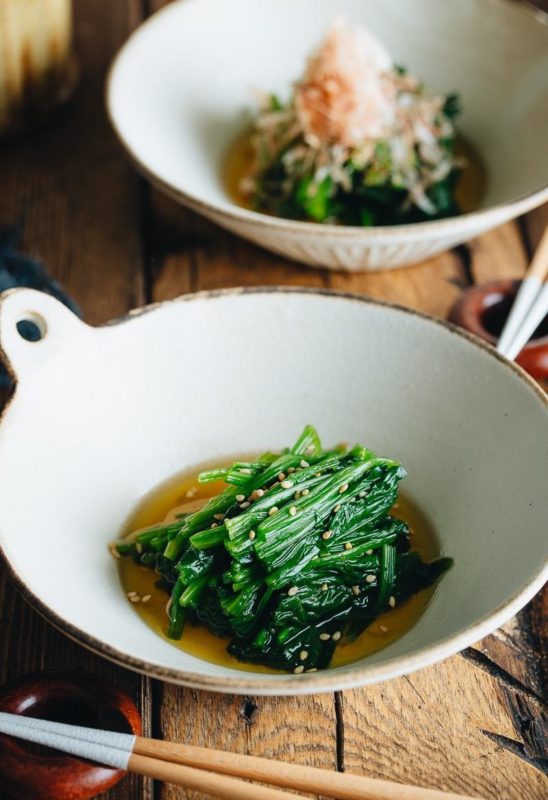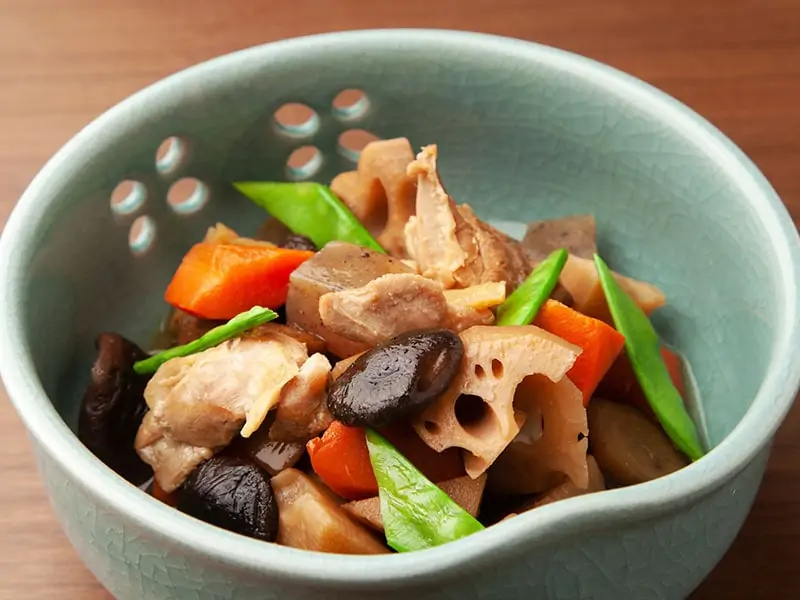Recipes
17 Delicious Japanese Vegetable Recipes 2022
If you’re looking for Japanese vegetable recipes for your next meal, you’ve come to the right place. Did you know that there are a variety of Japanese vegetable dishes, from salads to soups, from stews to steamed rice with vegetables?
In this article, I will introduce you to a list of Japanese vegetable recipes that you can start with at your next meal or whenever you feel like eating vegetables. You will never get bored of them! (Japanese Vegetable Recipes)
Table of Contents
List of 17 Delicious Japanese Vegetable Recipes
Here is a list of all Japanese vegetable recipes that I will tell you about in this article.
- Sunomono – Japanese Cucumber Salad
- Nishime – Japanese Vegetable Stew
- Nasu Dengaku – Miso Glazed Eggplants
- Wafu Dressing Salad
- Takikomi Gohan – Japanese Mixed Rice
- Okra Salad
- Vegetable Tempura
- Miso Soup With Summer Vegetables
- Kenchinjiru – Japanese Vegetable Soup
- Glazed Kabocha Squash
- Sukiyaki
- Shabu-Shabu
- Vegetable Sushi Roll
- Kinpira Gobo – Japanese Stir-Fried Burdock And Carrot
- Edamame Furikake
- Japanese Kani Salad
- Japanese Potato Salad (Japanese Vegetable Recipes)
17 Healthy And Tasty Japanese Vegetable Recipes
Now that you’ve skimmed through the names of the dishes, let’s dive into more details about what each dish looks like and the recipe! (Japanese Vegetable Recipes)
1. Sunomono – Japanese Cucumber Salad
Sunomono refers to any dish mixed with vinegar, and so does this light and refreshing cucumber salad. If you are busy but want a simple and healthy vegetable dish to eat, you must try this!

The recipe is simple, and the main ingredients that enhance the cucumber are soy sauce, vinegar, and mirin, which is sweetened rice wine. The overall taste of this dish can be described as the freshness of cucumber mixed with salty and sourness. (Japanese Vegetable Recipes)
2. Nishime – Japanese Vegetable Stew
For this dish, you can combine many of your favorite root vegetables with mild yet flavorful Japanese seasonings. You can find it in many bento boxes sold in Japan, as it tastes good even at room temperature.
What makes this dish taste so great is the mix of dashi, soy sauce and mirin. By mixing these three ingredients, you get a slightly sweet and umami flavor that blends very well together. (Japanese Vegetable Recipes)
3. Nasu Dengaku – Miso Glazed Eggplants
This Nasu Dengaku is simply amazing! The umami taste of miso, enriched with spices such as dashi and mirin, is blended with the authentic taste of roasted eggplant.
Although it is a salty dish, it is not very salty, so you can enjoy the dish with or without rice and either option is still good. If you’re looking for a light meal, appetizer, side dish or even main course, this dish is delicious either way. (Japanese Vegetable Recipes)
4. Wafu Dressing Salad
What makes this salad special is the dressing! But for vegetables first, you can prepare all the basic vegetables commonly eaten in salads, such as lettuce, tomatoes, cucumbers, and finely cut or grated carrots.
Now, speaking of Wafu sauce, it’s delicious as it has sesame oil, rice vinegar, soy sauce, and a few other ingredients put together. A refreshing, healthy and delicious meal that should be in every meal! (Japanese Vegetable Recipes)
5. Takikomi Gohan – Japanese Mixed Rice
Great for vegetarians but for everyone in general! This mixed rice is very filling and healthy because you don’t need to use oil to fry the vegetables, but still taste great.
Before cooking the rice, simply add the vegetables like mushrooms, thinly sliced carrots, bamboo shoots, hijiki seaweed, few more ingredients, necessary seasonings and you will have a hot bowl of delicious rice dish.
The flavor of this rice is usually very mild, so you can have it with the main course. But if you want a light and vegetarian meal, you can also have it with just miso soup and tsukemono.
I highly recommend you try making this versatile mixed rice at home! (Japanese Vegetable Recipes)
6. Okra Salad
Another simple, light and refreshing salad to make! Garnishing with katsuobushi, which is Japanese fish flakes, enhances the flavor, but if you’re a vegetarian, you can enjoy the dish without the fish flakes.
It is also versatile in the way that you can eat the dish as an appetizer or as a side dish with other meals. It will be great when eaten with heavily flavored foods as it will reduce the flavor and give you a taste change. Okra salad can help increase your appetite during meals.
7. Vegetable Tempura
Vegetable tempura is no less tasty than shrimp tempura. The great thing about this dish is that you can enjoy the crispness of the fried dough with a variety of flavors from different vegetables. Zucchini and sweet potato tempura are my personal favorites as they are naturally sweet and pair very well with tempura sauce.
You don’t need to go to a restaurant to eat tempura, but you can make this mouthwatering dish completely at home!
8. Miso Soup With Summer Vegetables
Hot soup can be drunk not only for winter, but also for summer. With this simple ingredient using vegetables like tomatoes, eggplant, and cucumbers, this miso soup is warm, light, and refreshing. Very heartwarming!
There are two types of miso paste, white and red. Red miso paste is usually a little saltier and richer, while white miso is for those who like the lighter flavor of the soup. Both miso pastes go well with this soup, so you can choose the one you like.
9. Kenchinjiru – Japanese Vegetable Soup
No other soups are sold in Japanese restaurants around the world, but there is more to discover. If you think miso soup is the only good soup from Japan, you should try this soup!
There is no miso paste in it, instead it is cooked from broth dashi stock, soy sauce, and the sweetness of vegetables and tofu. On a day when you’re looking for a simple meal that will save you time, you can cook it with a bowl of hot rice covered with Japanese pickles and your meal is ready to eat.
Japanese Vegetable Soup (Kenchinjiru)Published bytheBakeologie
10. Glazed Kabocha Squash
When it comes to this dish, the natural sweetness of Kabocha and the sweet plus salty taste of all the seasonings are very healthy. Another good thing about it is that its ingredients are so simple that it’s also good for a busy day.
All you need is squash, soy sauce, sugar, ginger, sesame seeds, water and just a few small ingredients. So if you want a fast, nice and healthy meal, you should go for it.
11. Sukiyaki – Japanese Hot Pot
If making this casserole at home seems complicated and impossible, don’t worry because you sure can! First, you need a crock pot or a large soup pot. Next, you need to get all the necessary ingredients and seasonings for the stew: beef, enoki mushrooms, cabbage, shiitake mushrooms, tofu, eggs, soy sauce, dashi, mirin and a few more.
The broth is sweet, salty and full of natural sweetness from beef and vegetables. It’s best eaten on one of those cold nights to warm your body, but you can always have it. If you’ve never tried sukiyaki, it’s worth a try. Very tasty and heartwarming!
12. Shabu-Shabu
This is another body-warming stew that also contains many nutritious ingredients. It is quite similar to sukiyaki, but instead of sweet and salty broth, all the ingredients are thrown into boiling water.
The steamed meat and vegetables are then dipped in two kinds of sauces. One is sesame sauce and the other is Ponzu so you can dip it back and forth in your preferred sauce. Shabu-shabu and Sukiyaki are two must-try Japanese hot pots!
13. Vegetable Sushi Roll
Vegetable sushi can be eaten as a convenient meal or even a snack, and what could be better as a snack than a healthy vegetable sushi roll? You may see avocado rolls or cucumber rolls in supermarkets or Sushi restaurants, but if you make a roll at home, you can add different types of vegetable fillings such as carrots and spinach to your sushi!
14. Kinpira Gobo – Japanese Stir-Fried Burdock And Carrot
This is another sweet and savory dish due to its mix of seasonings like savory soy sauce, umami-flavored dashi, and sweet mirin. All the ingredients like carrot, burdock, sesame seeds and a few ingredients mixed with the above seasonings mix very well.
Another similar dish is lotus roots and carrots. You can substitute burdock for the lotus roots and it still tastes great.
Although it is a pan-fried dish, it is not heavy and oily at all, on the contrary, it is light, delicious and healthy!
15. Edamame Furikake
Furikake are savory sauces that help enhance the flavor of the rice and make it easier to eat, especially when there isn’t a lot of salty food available.
Edamame furikake not only enhances the taste of rice, but also contains protein and other nutritional factors that are good for your health. It’s delicious and healthy in this one-topped dish!
16. Japanese Kani Salad
The surprising thing about Japanese Kani salad is that it is creamy but not heavy, quite light in texture. Kani salad literally means crab salad, but the “crab meat” here is imitation crabmeat that usually comes in bars the size of a chocolate bar.
As I mentioned above, it’s creamy and light, so besides creamy, you can feel the real taste of ingredients like cucumbers, shallots, imitation crab and more depending on the additional ingredients you want to add.
17. Japanese Potato Salad
Another creamy salad dish, creamy, light and refreshing! You can find this salad very popular in Japanese bento boxes and even as a side dish for many main dishes. Depending on whether you’re vegetarian or not, adding bacon to a salad enhances its flavor.
Since the salad itself is not overly pronounced and quite light, it can go well with meat, fish and even other vegetable dishes. It somehow reminds you of regular mashed potatoes, but much lighter in texture and richer in flavor.
Were You Able To Find Your Favorite Recipe?
Japanese vegetable dishes are healthy but can sometimes seem complicated when eaten at a restaurant. Large dishes, especially casseroles, require more ingredients and you may find it impossible to make them at home.
But with the right recipe and instructions, you will understand that the cooking process is not as difficult as it seems. Most of the ingredients for the above dishes can be easily found in nearby supermarkets or Asian markets. Making sukiyaki or Shabu-shabu at home will save you from having to walk or drive to Japanese restaurants when you crave a hot pot.
Have you tried making any of the above dishes? What are your favorite Japanese vegetable recipes? Would you rather eat this kind of simple Japanese food at home or eat out more? Feel free to share your thoughts with me!

Also, don’t forget to pin/bookmark and visit our blog for more interesting but original information. (Vodka And Grape Juice)

i tried it and i like it thanks